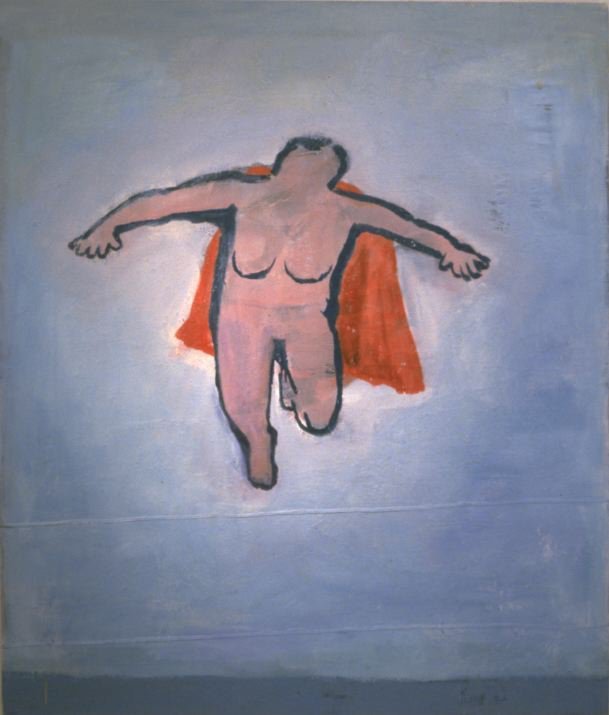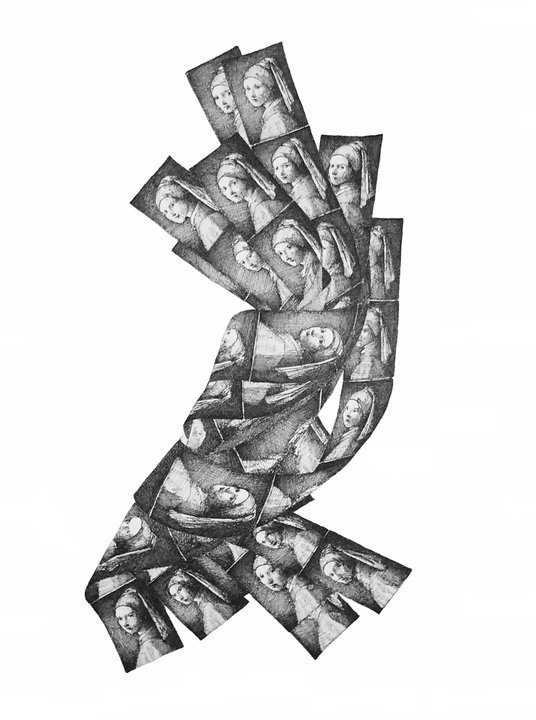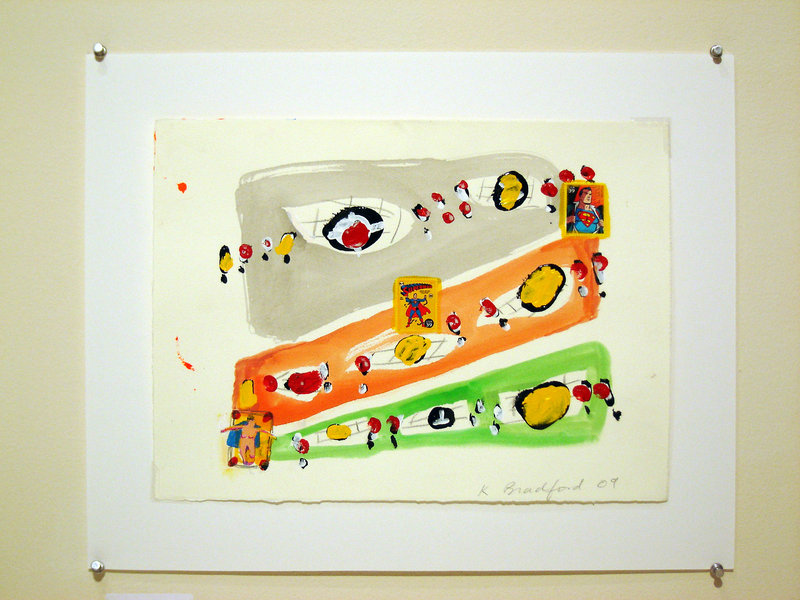Aaron Stephan’s drawings at his Aucocisco show ribbons and sheets of hundreds of tiny images of Johannes Vermeer’s 1665 painting, “Girl with a Pearl Earring.”
They directly reference Peter Webber’s 2003 film “Girl with a Pearl Earring,” based on the painting and starring Scarlett Johansson as the girl and Colin Firth as the dour Vermeer.
Stephan’s works are drawings about a movie about a painting.
This is Pop Art doing what it does best: driving the vehicle of visual art to consider issues of repetition, portability, recycled imagery and popularity as vital elements of our popular culture.
Vermeer’s painting shows a young woman in three-quarter pose turning towards the viewer from profile. She is wearing a blue and bisque scarf over her head, an ochre tunic over a white blouse and a voluptuous pearl earring. There is no background other than darkness that throws the figure — glowing in softly raking light — into high relief.
Her face is tentative and demure. Her glinting eyes rise to yours. Her mouth is slightly agape — more surprised than ready to speak. Her moist lower lip is worthy of the novels it has inspired.
We have no idea who the original model was. In fact, we know very little about Vermeer. He was neither famous nor particularly influential. Considering there are only 34 of his paintings known to exist, he doesn’t even appear to have been particularly successful.
Yet Vermeer casts a spell upon so many of us.
“Corporeal,” the title of the two-person show with Katherine Bradford, is rather ironic since Stephan has chosen to follow Andy Warhol’s logic of multiplicities, and the only corporeal reality is that of uber-hottie Johansson — a real person only as an actress playing a fictionalized role. (Warhol’s many pictures of Marilyn Monroe, for example, are less about her and more about the omnipresence of her image.)
For these pen-and-ink drawings repeating the image over and over, Stephan has used an engraving style (crosshatching, etc). You quickly get the idea the drawings are from images both of Johansson and the Vermeer — and then from Stephan’s own drawings that, after a while, take on a life of their own.
Several of Stephan’s elegantly presented black-ink drawings on large white sheets of paper in handsomely large white frames are knotted bunches of film that could be the detritus from Webber’s cutting-room floor. Others are shown as sheets — maybe folded into a fan as though someone was absentmindedly playing with scrap paper.
Stephan also presents six large, people-shaped crates previously seen at the University of Maine’s Museum of Art. These are grouped in welcome — facing the gallery’s entrance as though citizens waiting for a bus. Unlike the serious repose of sarcophagi (human-shaped caskets), these giant, standing forms are casual, even friendly.
Again, “Corporeal” rings odd. These are not bodies, but boxes for bodies. Even the title — “Vessels Absent” — encourages their reading as empty containers. While seemingly disconnected from the drawings, the Warhol/Pop Art reading of the works pulls them together brilliantly — all those images of Monroe were not actually her, but images — empty containers we fill with our own projections.
Not even Warhol addressed the issue of the portability of culture as sharply as Stephan’s simple gesture of putting handles on his “people” crates.
Bradford’s portion of “Corporeal” is based on the large canvas “Woman Flying,” shown previously in the 2001 Portland Museum of Art Biennial.
“Woman Flying” depicts an awkwardly rendered, squat-necked, featureless female figure with a red cape. Feminist but not feminine, she is womanly only by dint of her crude U-shaped breasts and her nakedness. Yet despite its almost agonizing simplicity and bedraggled lines, it’s a striking image with a rich surface.
Eight of the 10 works by Bradford echo “Woman Flying” as drawn or reproduced images — pulling this half of the show into the Pop Art logic so masterfully handled by Stephan. But Bradford’s self-referential repetition falls flat when compared to the majesty of Stephan’s reverential conjuring of Vermeer’s masterpiece.
“Super Stamps” reveals Bradford’s fain envy of Superman, an orphan whose alien humanity outstrips our own. It’s a jaunty composition that lilts back from two Superman postal stamps to the lower left, where “Flying Woman”‘s effervescently dotted paint baubles energize her. But Clark Kent wants to hide his heroics and be an average person. His admirable humility feels like kryptonite to “Flying Woman.” Superman sizzles for us, then retreats from the spotlight to be himself.
While I am not particularly impressed with Bradford’s self-branding (though spunky) work, I do think it’s an excellent complement to Stephan’s vigilantly brilliant foray into Pop Art’s here-and-now cultural critique and insights. “Corporeal” is an appealing, exciting and accessible show for superheroes and their fans of all ages.
Freelance writer Daniel Kany is an art historian who lives in Cumberland. He can be contacted at:
dankany@gmail.com
Send questions/comments to the editors.





Success. Please wait for the page to reload. If the page does not reload within 5 seconds, please refresh the page.
Enter your email and password to access comments.
Hi, to comment on stories you must . This profile is in addition to your subscription and website login.
Already have a commenting profile? .
Invalid username/password.
Please check your email to confirm and complete your registration.
Only subscribers are eligible to post comments. Please subscribe or login first for digital access. Here’s why.
Use the form below to reset your password. When you've submitted your account email, we will send an email with a reset code.